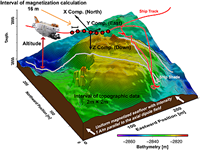Toward continuous quantification of lava extrusion rate: Results from the multidisciplinary analysis of the 2 January 2010 eruption of Piton de la Fournaise volcano, La Réunion
Hibert C., A. Mangeney, M. Polacci, A. Di Muro, S. Vergniolle, V. Ferrazzini, A. Peltier, B. Taisne, M. Burton, T. Dewez, G. Grandjean, A. Dupont, T. Staudacher, F. Brenguier, P. Kowalski, P. Boissier, P. Catherine and F. Lauret (2015).
Journal of Geophysical Research – Solid Earth, Volume 120, Issue 5, Pages 3026–3047, doi:10.1002/2014JB011769.
Abstract
The dynamics of the 2–12 January 2010 effusive eruption at Piton de la Fournaise volcano were examined through seismic and infrasound records, time-lapse photography, SO2 flux measurements, deformation data, and direct observations. Digital elevation models were constructed for four periods of the eruption, thus providing an assessment of the temporal evolution of the morphology, the volume and the extrusion rate of the lava flow. These data were compared to the continuous recording of the seismic and infrasonic waves, and a linear relationship was found between the seismic energy of the tremor and the lava extrusion rate. This relationship is supported by data from three other summit eruptions of Piton de la Fournaise and gives total volume and average lava extrusion rate in good agreement with previous studies. We can therefore provide an estimate of the lava extrusion rate for the January 2010 eruption with a very high temporal resolution. We found an average lava extrusion rate of 2.4 m3s−1 with a peak of 106.6 m3s−1 during the initial lava fountaining phase. We use the inferred average lava extrusion rate during the lava fountaining phase (30.23 m3s−1) to estimate the value of the initial overpressure in the magma reservoir, which we found to range from 3.7×106 Pa to 5.9×106 Pa. Finally, based on the estimated initial overpressure, the volume of magma expelled during the lava fountaining phase and geodetic data, we inferred the volume of the magma reservoir using a simple Mogi model, between 0.25 km3 and 0.54 km3, which is in good agreement with previous studies.
http://onlinelibrary.wiley.com/doi/10.1002/2014JB011769/full


